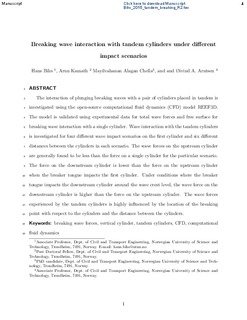| dc.contributor.author | Bihs, Hans | |
| dc.contributor.author | Kamath, Arun | |
| dc.contributor.author | Alagan Chella, Mayilvahanan | |
| dc.contributor.author | Arntsen, Øivind Asgeir | |
| dc.date.accessioned | 2016-09-22T06:45:38Z | |
| dc.date.accessioned | 2016-09-29T09:27:00Z | |
| dc.date.available | 2016-09-22T06:45:38Z | |
| dc.date.available | 2016-09-29T09:27:00Z | |
| dc.date.issued | 2016 | |
| dc.identifier.citation | Journal of waterway, port, coastal, and ocean engineering 2016, 142(5) | nb_NO |
| dc.identifier.issn | 0733-950X | |
| dc.identifier.uri | http://hdl.handle.net/11250/2411722 | |
| dc.description.abstract | The interaction of plunging breaking waves with a pair of cylinders placed in tandem is investigated using an open-source computational fluid dynamics (CFD) model. The model is validated using experimental data for total wave forces and free surface elevations for breaking-wave interaction with a single cylinder. Wave interaction with tandem cylinders is investigated for four different wave impact scenarios on the first cylinder and six different distances between the cylinders in each scenario. Wave forces on the upstream cylinder are generally found to be less than the forces on a single cylinder for a particular scenario. The force on the downstream cylinder is lower than the force on the upstream cylinder when the breaker tongue impacts the first cylinder. Under conditions in which the breaker tongue impacts the downstream cylinder around the wave crest level, the wave force on the downstream cylinder is higher than the force on the upstream cylinder. The wave forces experienced by the tandem cylinders is highly influenced by the location of the breaking point with respect to the cylinders and the distance between the cylinders. | nb_NO |
| dc.language.iso | eng | nb_NO |
| dc.publisher | American Society of Civil Engineers | nb_NO |
| dc.title | Breaking wave interaction with tandem cylinders under different impact scenarios | nb_NO |
| dc.type | Journal article | nb_NO |
| dc.type | Peer reviewed | nb_NO |
| dc.date.updated | 2016-09-22T06:45:38Z | |
| dc.source.volume | 142 | nb_NO |
| dc.source.journal | Journal of waterway, port, coastal, and ocean engineering | nb_NO |
| dc.source.issue | 5 | nb_NO |
| dc.identifier.doi | 10.1061/(ASCE)WW.1943-5460.0000343 | |
| dc.identifier.cristin | 1337346 | |
| dc.description.localcode | © 2016 American Society of Civil Engineers. This is the authors' accepted and refereed maniscript to the article. | nb_NO |
